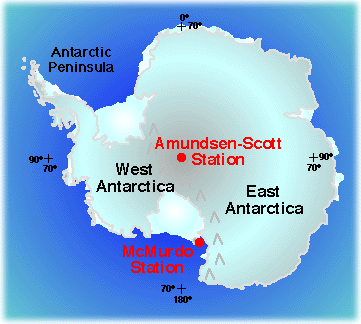
Antarctic Muon and Neutrino Detector Array (AMANDA)
Dr. Robert Morse, The University of Wisconsin
Scientists believe that neutrinos are produced from exotic and violent cosmic objects in the universe. Neutrinos, which were first postulated to exist by Enrico Fermi, are difficult to detect due to their neutral charge and negligable mass. Neutrinos can pass right through large amounts of matter without interacting at all. In fact, trillions of neutrinos are passing through your body right now, every second!
Neutrinos cannot be seen, but they can be detected indirectly when the interact with the nuclues of an atom found in a water molecule. When a neutrino interacts with a water nuclei, a mid-sized parcticle called a muon is ejected in the same direction of the original neutrino. The muon that emerges is very energetic and moves at a speed very close to the speed of light in a vacuum (c). The speed of light in ice is less than the speed of light in a vacuum, so that means the muon travels through the ice at a speed faster than the light can travel through the ice. Just as when a supersonic jet flies faster than the speed of sound, the muon creates a shock wave in the ice. However, instead of sound, the muon produces light called Cherenkov radiation. This light travels outward from the muon's track in a cone similar to the wake a boat produces traveling through water. This light is what AMANDA detects and uses to reconstruct the direction of the muon, and the original neutrino.
AMANDA consists of an array of several hundred Optical Modules, or light detectors. When a muon travels passes through AMANDA giving off Cherenkov light, the detectors records which modules see light, and precisely when the light is seen by each. In order for AMANDA to work correctly, it must be placed in a location that has an abundance of pure, uncontaminated water. The South Pole contains 9000 feet of ice, thus providing the perfect location for its construction. Now that the construction of AMANDA is complete, there are plans to build an even larger detector called ICECUBED. For more information, check out the Amanda Web site.
Jason will be working closely with Mats Pettersson who teaches at Angeredsgymnasiet School in Goteborg, Sweden. Matts is the first Swedish teacher working at the The Swedish Polar Secretariat. Check out his home page at Angeredsgymnasiet.

 Be sure to check out the images in the journal entries!
Be sure to check out the images in the journal entries!
